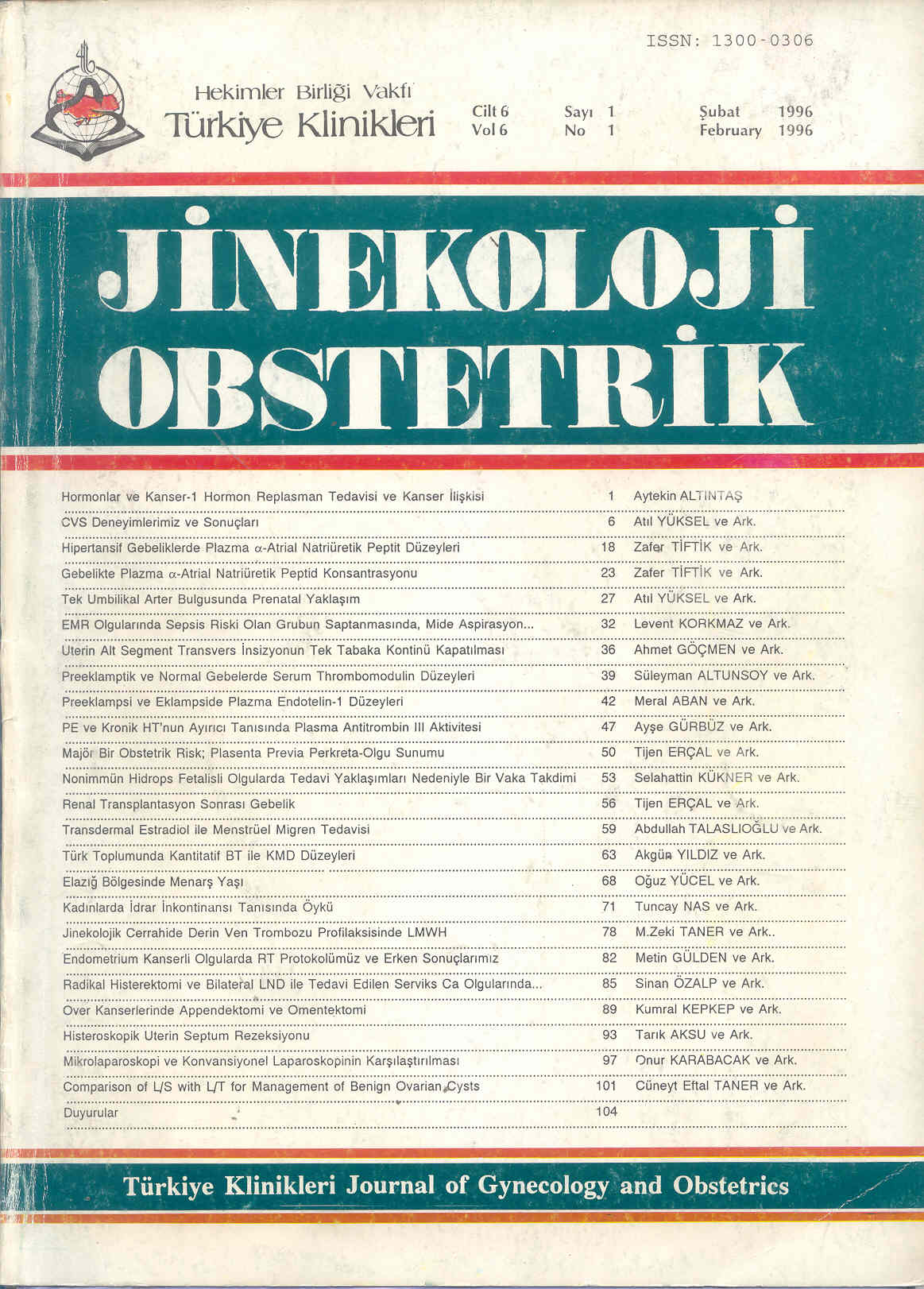Open Access
Peer Reviewed
ARTICLES
3397 Viewed1124 Downloaded
Assessment Of The Value Of Patients History In The Diagnosis Of Female Urinary Incontinence Using Urodynamic Diagnosis As "Gold Standard"
Kadınlarda İdrar İnkontinansı Tanısında Öykünün Güvenirliliğinin Değerlendirilmesi
Turkiye Klinikleri J Gynecol Obst. 1996;6(1):71-7
Article Language: TR
Copyright Ⓒ 2025 by Türkiye Klinikleri. This is an open access article under the CC BY-NC-ND license (http://creativecommons.org/licenses/by-nc-nd/4.0/)
ÖZET
Amaç: İdrar inkontinansı şikayeti olan kadınlarda öykü ile konulan tanının güvenirliliğinin incelenmesi. Çalışmanın Yapıldığı Yer: Gazi Üniversitesi Tıp Fakültesi Kadın Hastalıkları ve Doğum AD. Materyel ve Metod: İdrar inkontinansı şikayeti ile başvuran 96 kadın hastanın öyküsü alınıp daha sonra ürodinamik çalışma gerçekleştirilmiştir. Hastalar öyküye göre gerçek stress inkontinans, detrüsör instabilitesi, mikst inkontinans ve kontinans olmak üzere 4 tanı grubuna ayrılmışlar, ürodinamik çalışma sonrası ortaya çıkan tanılar ile karşılaştırılmışlardır. Bulgular: Ürodinamik çalışma tanıda "gold standard" olarak kabul edildiğinde öykünün doğru tanı koyma başarısı %60.4 olup, bu değer gerçek stress inkontinansda %73, detrüsör instabilitesinde %60, mikst inkontinansda ise %75 bulunmuştur. Urgency, pollakiüri, noktüri ve noktürnal enürez semptomları unstabil mesanelerde daha sık görülmelerine karşın inkontinans tipinin tayininde önemli bir rol oynamamıştır. Sonuç: İdrar inkontinansı tanısında sadece öykü bulguları yeterli olmayıp, mutlaka ürodinamik çalışma ile değerlendirmek gereklidir.
Amaç: İdrar inkontinansı şikayeti olan kadınlarda öykü ile konulan tanının güvenirliliğinin incelenmesi. Çalışmanın Yapıldığı Yer: Gazi Üniversitesi Tıp Fakültesi Kadın Hastalıkları ve Doğum AD. Materyel ve Metod: İdrar inkontinansı şikayeti ile başvuran 96 kadın hastanın öyküsü alınıp daha sonra ürodinamik çalışma gerçekleştirilmiştir. Hastalar öyküye göre gerçek stress inkontinans, detrüsör instabilitesi, mikst inkontinans ve kontinans olmak üzere 4 tanı grubuna ayrılmışlar, ürodinamik çalışma sonrası ortaya çıkan tanılar ile karşılaştırılmışlardır. Bulgular: Ürodinamik çalışma tanıda "gold standard" olarak kabul edildiğinde öykünün doğru tanı koyma başarısı %60.4 olup, bu değer gerçek stress inkontinansda %73, detrüsör instabilitesinde %60, mikst inkontinansda ise %75 bulunmuştur. Urgency, pollakiüri, noktüri ve noktürnal enürez semptomları unstabil mesanelerde daha sık görülmelerine karşın inkontinans tipinin tayininde önemli bir rol oynamamıştır. Sonuç: İdrar inkontinansı tanısında sadece öykü bulguları yeterli olmayıp, mutlaka ürodinamik çalışma ile değerlendirmek gereklidir.
ANAHTAR KELİMELER: İdrar inkontinansı, ürodinamik çalışma, idrar yolları semptomları
ABSTRACT
Objective: To assess the value of patient's history in the diagnosis of female urinary incontinence. Institution: Gazi University Faculty of Medicine, Department of Obstetrics and Gynecology. Material and Method: A total of 96 women with complaint of urinary incontinence has been assessed by history taking. Patients were separated into four groups according to their presenting symptoms as genuine stress incontinence, detrusor instability and mixed incontinence. We evaluated the value of patient's history by comparing with urodynamic diagnosis accepted as "gold standard" in the diagnosis of urinay incontinence. Results: Overall correct diagnosis of patient's history was 60.4%, accepting urodynamic study as "gold standard" in the diagnosis of urinary incontinence. History of genuine stress incontinence, detrusor instability and mixed incontinence had correct diagnosis of 73%, 60%, 75% respectively. Symptoms of urgency, frequency, nocturia, nocturnal enuresis had no significant value in diagnosing the type of incontinence. Conclusion: Patient's history is not a good predictor of urinary incontinence and it must be accompanied by urodynamic study for the final diagnosis.
Objective: To assess the value of patient's history in the diagnosis of female urinary incontinence. Institution: Gazi University Faculty of Medicine, Department of Obstetrics and Gynecology. Material and Method: A total of 96 women with complaint of urinary incontinence has been assessed by history taking. Patients were separated into four groups according to their presenting symptoms as genuine stress incontinence, detrusor instability and mixed incontinence. We evaluated the value of patient's history by comparing with urodynamic diagnosis accepted as "gold standard" in the diagnosis of urinay incontinence. Results: Overall correct diagnosis of patient's history was 60.4%, accepting urodynamic study as "gold standard" in the diagnosis of urinary incontinence. History of genuine stress incontinence, detrusor instability and mixed incontinence had correct diagnosis of 73%, 60%, 75% respectively. Symptoms of urgency, frequency, nocturia, nocturnal enuresis had no significant value in diagnosing the type of incontinence. Conclusion: Patient's history is not a good predictor of urinary incontinence and it must be accompanied by urodynamic study for the final diagnosis.
MENU
POPULAR ARTICLES
MOST DOWNLOADED ARTICLES





This journal is licensed under a Creative Commons Attribution-NonCommercial-NoDerivatives 4.0 International License.










